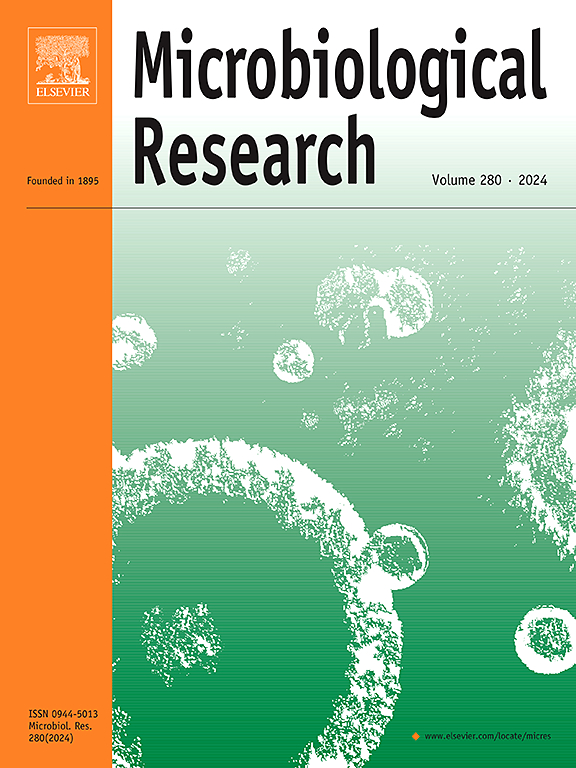DBP降解和pgpr介导的增强:玉米(Zea mays L.)转录组和根际微生物组分析揭示肠杆菌X1的机制
IF 6.1
1区 生物学
Q1 MICROBIOLOGY
引用次数: 0
摘要
邻苯二甲酸二丁酯(DBP)是工业生产中常见的增塑剂,在农业领域中经常被检测到,对人类的内分泌有显著的干扰作用。近年来,促进植物生长的根瘤菌(PGPR)因其在植物修复土壤有机污染物方面的应用而受到广泛关注。然而,很少有研究通过植物转录组和根茎微生物组分析揭示了pgpr辅助植物修复过程中基因表达变化的潜在机制。因此,我们分离出一株具有多种PGP特性的dbp降解菌,并将其命名为菌株X1。研究了接种菌株X1对促进玉米(Zea mays L.)修复dbp污染土壤的影响。结果表明,与DBP组相比,DBP + X1处理组土壤DBP去除率提高29.3 % (P <; 0.05),玉米DBP积累量显著降低(P <; 0.05)。一方面,转录组分析进一步表明,接种菌株X1后,植株组织中解毒酶和抗氧化剂的基因表达上调,可以防止玉米DBP的过量积累。此外,菌株X1可以通过诱导光合信号通路相关蛋白编码基因的表达来改善玉米光合作用。另一方面,菌株X1的引入极大地调整了土壤微生物群落的多样性,增加了dbp污染土壤中降解细菌的丰度,提高了土壤酶活性。特别的是,本研究还发现一些植物基因的表达与根际微生物的相对丰度密切相关,如Massilia和Devosia与碱性磷酸酶合成相关基因的表达上调有关,这对进一步探索微生物与植物的相互作用机制具有重要意义。因此,本研究通过植物转录组和根际微生物组分析,探讨了植物修复过程中PGPR对植物生长和dbp污染土壤修复的作用,为未来污染农田修复机制研究提供了新的视角。本文章由计算机程序翻译,如有差异,请以英文原文为准。
DBP degradation and PGPR-mediated enhancement: Mechanisms of Enterobacter sp. X1 revealed by maize (Zea mays L.) transcriptome and rhizosphere microbiome analysis
Dibutyl phthalate (DBP), a common plasticizer in industrial production, is often detected in agricultural fields and exhibits significant endocrine disrupting effects on humans. Recently, plant growth promoting rhizobacteria (PGPR) have received considerable attention for their application in enhancing phytoremediation of soil organic pollutants. However, few studies have revealed the underlying mechanisms of gene expression changes in the PGPR-assisted phytoremediation process through plant transcriptome and rhizome microbiome analyses. Therefore, a DBP-degrading bacterium with multiple PGP traits was isolated, characterized and named strain X1. The effects of strain X1 inoculation on the promotion of maize (Zea mays L.) to remediate DBP-contaminated soil were then evaluated. The results showed that, compared to the DBP group, the soil DBP removal efficiency in the DBP + X1 treatment group increased 29.3 % (P < 0.05), accompanied by a significant reduction in DBP accumulation in maize (14.5 %) (P < 0.05). On one hand, transcriptome analysis further revealed that gene expression of detoxifying enzymes and antioxidants in plant tissues was up-regulated after inoculation with strain X1, which could prevent the excessive DBP accumulation in maize. Additionally, strain X1 could improve maize photosynthesis by inducing the expression of genes encoding proteins involved in the photosynthetic signaling pathway. On the other hand, the introduction of strain X1 greatly adjusted the diversity of the soil microbial community, enriched the abundance of DBP-degrading bacteria and improved soil enzyme activities in DBP-contaminated soil. In particular, this study also found that the expression of some plant genes was closely related to the relative abundance of rhizosphere microorganisms, such as Massilia and Devosia were associated with up-regulation of the expression of genes involved in the synthesis of alkaline phosphatase, which was of great importance in further exploration of microbial-plant interaction mechanisms. Consequently, this study investigated the role of PGPR on plant growth and the remediation of DBP-contaminated soil during phytoremediation through plant transcriptome and rhizosphere microbiome analysis, which provided a new perspective for future mechanism research on the remediation of contaminated farmland.
求助全文
通过发布文献求助,成功后即可免费获取论文全文。
去求助
来源期刊

Microbiological research
生物-微生物学
CiteScore
10.90
自引率
6.00%
发文量
249
审稿时长
29 days
期刊介绍:
Microbiological Research is devoted to publishing reports on prokaryotic and eukaryotic microorganisms such as yeasts, fungi, bacteria, archaea, and protozoa. Research on interactions between pathogenic microorganisms and their environment or hosts are also covered.
 求助内容:
求助内容: 应助结果提醒方式:
应助结果提醒方式:


